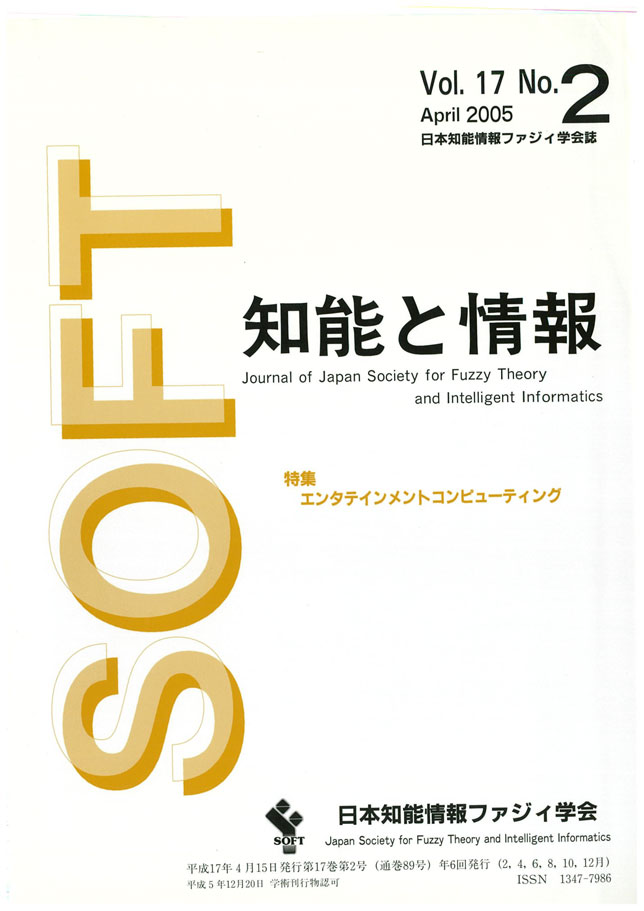Volume 17, Issue 2
Displaying 1-33 of 33 articles from this issue
- |<
- <
- 1
- >
- >|
-
Article type: Index
2005 Volume 17 Issue 2 Pages Toc2-
Published: April 15, 2005
Released on J-STAGE: December 19, 2017
Download PDF (70K)
-
Article type: Appendix
2005 Volume 17 Issue 2 Pages 137-
Published: April 15, 2005
Released on J-STAGE: May 03, 2017
Download PDF (87K) -
Article type: Article
2005 Volume 17 Issue 2 Pages 138-139
Published: April 15, 2005
Released on J-STAGE: May 03, 2017
Download PDF (310K) -
Article type: Article
2005 Volume 17 Issue 2 Pages 139-
Published: April 15, 2005
Released on J-STAGE: May 03, 2017
Download PDF (177K) -
Article type: Article
2005 Volume 17 Issue 2 Pages 140-141
Published: April 15, 2005
Released on J-STAGE: May 03, 2017
Download PDF (325K) -
Article type: Article
2005 Volume 17 Issue 2 Pages 141-142
Published: April 15, 2005
Released on J-STAGE: May 03, 2017
Download PDF (320K)
-
Article type: Article
2005 Volume 17 Issue 2 Pages 143-
Published: April 15, 2005
Released on J-STAGE: May 03, 2017
Download PDF (140K)
-
Article type: Article
2005 Volume 17 Issue 2 Pages 144-145
Published: April 15, 2005
Released on J-STAGE: May 03, 2017
Download PDF (175K)
-
Article type: Article
2005 Volume 17 Issue 2 Pages 146-149
Published: April 15, 2005
Released on J-STAGE: May 03, 2017
Download PDF (499K) -
Article type: Article
2005 Volume 17 Issue 2 Pages 150-155
Published: April 15, 2005
Released on J-STAGE: May 03, 2017
Download PDF (1016K) -
Article type: Article
2005 Volume 17 Issue 2 Pages 156-163
Published: April 15, 2005
Released on J-STAGE: May 03, 2017
Download PDF (1114K)
Original Papers
-
Article type: Article
2005 Volume 17 Issue 2 Pages 164-174
Published: April 15, 2005
Released on J-STAGE: May 03, 2017
Download PDF (1381K) -
Article type: Article
2005 Volume 17 Issue 2 Pages 175-183
Published: April 15, 2005
Released on J-STAGE: May 03, 2017
Download PDF (874K) -
Article type: Article
2005 Volume 17 Issue 2 Pages 184-193
Published: April 15, 2005
Released on J-STAGE: May 03, 2017
Download PDF (996K) -
Article type: Article
2005 Volume 17 Issue 2 Pages 194-202
Published: April 15, 2005
Released on J-STAGE: May 03, 2017
Download PDF (1503K) -
Article type: Article
2005 Volume 17 Issue 2 Pages 203-211
Published: April 15, 2005
Released on J-STAGE: May 03, 2017
Download PDF (1510K) -
Article type: Article
2005 Volume 17 Issue 2 Pages 212-221
Published: April 15, 2005
Released on J-STAGE: May 03, 2017
Download PDF (1285K) -
Article type: Article
2005 Volume 17 Issue 2 Pages 222-232
Published: April 15, 2005
Released on J-STAGE: May 03, 2017
Download PDF (1168K) -
Article type: Article
2005 Volume 17 Issue 2 Pages 233-242
Published: April 15, 2005
Released on J-STAGE: May 03, 2017
Download PDF (1219K)
Short Notes
-
Article type: Article
2005 Volume 17 Issue 2 Pages 243-249
Published: April 15, 2005
Released on J-STAGE: May 03, 2017
Download PDF (991K) -
Article type: Article
2005 Volume 17 Issue 2 Pages 250-255
Published: April 15, 2005
Released on J-STAGE: May 03, 2017
Download PDF (1074K)
-
Article type: Article
2005 Volume 17 Issue 2 Pages 256-258
Published: April 15, 2005
Released on J-STAGE: May 03, 2017
Download PDF (378K) -
Article type: Appendix
2005 Volume 17 Issue 2 Pages 258-
Published: April 15, 2005
Released on J-STAGE: May 03, 2017
Download PDF (53K)
-
Article type: Article
2005 Volume 17 Issue 2 Pages 259-266
Published: April 15, 2005
Released on J-STAGE: May 03, 2017
Download PDF (1415K)
-
Article type: Article
2005 Volume 17 Issue 2 Pages 267-268
Published: April 15, 2005
Released on J-STAGE: May 03, 2017
Download PDF (224K)
-
Article type: Article
2005 Volume 17 Issue 2 Pages 269-
Published: April 15, 2005
Released on J-STAGE: May 03, 2017
Download PDF (169K)
-
Article type: Article
2005 Volume 17 Issue 2 Pages 270-
Published: April 15, 2005
Released on J-STAGE: May 03, 2017
Download PDF (167K) -
Article type: Article
2005 Volume 17 Issue 2 Pages 270-
Published: April 15, 2005
Released on J-STAGE: May 03, 2017
Download PDF (167K)
-
Article type: Article
2005 Volume 17 Issue 2 Pages 271-
Published: April 15, 2005
Released on J-STAGE: May 03, 2017
Download PDF (237K)
-
Article type: Appendix
2005 Volume 17 Issue 2 Pages 273-
Published: April 15, 2005
Released on J-STAGE: May 03, 2017
Download PDF (78K) -
Article type: Appendix
2005 Volume 17 Issue 2 Pages 273-
Published: April 15, 2005
Released on J-STAGE: May 03, 2017
Download PDF (78K) -
Article type: Bibliography
2005 Volume 17 Issue 2 Pages 274-
Published: April 15, 2005
Released on J-STAGE: May 03, 2017
Download PDF (25K)
-
Article type: Appendix
2005 Volume 17 Issue 2 Pages A1-A8
Published: April 15, 2005
Released on J-STAGE: May 03, 2017
Download PDF (388K)
- |<
- <
- 1
- >
- >|
